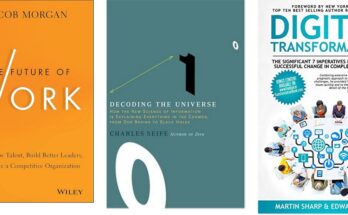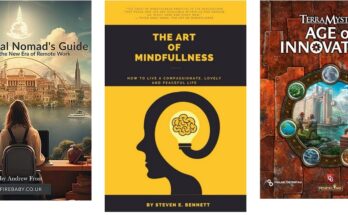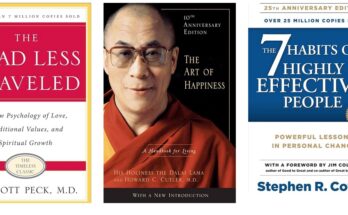


The Highly Sensitive Person" by Elaine N. Aron vs "The Emotional Life of Your Brain" by Richard J. Davidson and Sharon Begley vs "The Defining Decade: Why Your Twenties Matter" by Meg Jay
Comparison in Brief
“The Highly Sensitive Person” by Elaine N. Aron
- Author: Elaine N. Aron
- Publication Year: 1996
- Genre: Psychology, Self-help
- Core Theme: Understanding and embracing high sensitivity as a personality trait.
- Main Concepts:
- The characteristics and challenges of highly sensitive individuals (HSPs).
- Strategies for HSPs to thrive in a world that may not always accommodate their needs.
- The biological and psychological underpinnings of sensitivity.
- Style: Compassionate, informative, and supportive.
- Impact: Provides validation and practical advice for highly sensitive people, helping them navigate their unique experiences.
“The Emotional Life of Your Brain” by Richard J. Davidson and Sharon Begley
- Authors: Richard J. Davidson and Sharon Begley
- Publication Year: 2012
- Genre: Neuroscience, Psychology
- Core Theme: How brain activity shapes our emotions and personalities.
- Main Concepts:
- The six emotional styles and their neural basis.
- Techniques for altering brain activity to improve emotional well-being.
- The impact of neuroplasticity on emotional regulation.
- Style: Scientific, accessible, and practical.
- Impact: Offers insights into the neuroscience of emotions and practical advice for improving emotional health.
“The Defining Decade: Why Your Twenties Matter” by Meg Jay
- Author: Meg Jay
- Publication Year: 2012
- Genre: Self-help, Developmental Psychology
- Core Theme: The critical importance of the twenties for shaping one’s future.
- Main Concepts:
- The significance of career, relationships, and identity development in the twenties.
- Practical advice for making the most of this formative decade.
- The psychological and social factors influencing young adults.
- Style: Engaging, motivational, and evidence-based.
- Impact: Encourages young adults to take proactive steps in their twenties to build a strong foundation for their future.
Table Comparison
| Aspect | “The Highly Sensitive Person” | “The Emotional Life of Your Brain” | “The Defining Decade” |
|---|---|---|---|
| Author | Elaine N. Aron | Richard J. Davidson, Sharon Begley | Meg Jay |
| Publication Year | 1996 | 2012 | 2012 |
| Genre | Psychology, Self-help | Neuroscience, Psychology | Self-help, Developmental Psychology |
| Core Theme | Embracing high sensitivity | How brain activity shapes emotions | Importance of the twenties |
| Main Concepts | – Characteristics of HSPs | – Six emotional styles | – Significance of career, relationships, and identity development in twenties |
| – Strategies for thriving | – Neural basis of emotions | – Practical advice for young adults | |
| – Biological and psychological underpinnings | – Techniques for altering brain activity | – Psychological and social factors influencing young adults | |
| Style | Compassionate, Informative | Scientific, Accessible | Engaging, Motivational |
| Impact | Provides validation and practical advice for HSPs | Insights into the neuroscience of emotions | Encourages proactive steps in the twenties |
In-Depth Comparison
“The Highly Sensitive Person” by Elaine N. Aron
Elaine N. Aron’s “The Highly Sensitive Person” is a pioneering work that sheds light on the experiences and needs of highly sensitive individuals (HSPs). Aron, a clinical psychologist, provides an empathetic and insightful exploration of what it means to be highly sensitive in a world that often values toughness and resilience over sensitivity.
Key Concepts:
- Characteristics of HSPs: Aron identifies high sensitivity as a personality trait found in about 15-20% of the population. HSPs tend to process sensory information more deeply, which can lead to greater empathy, creativity, and awareness, but also to overwhelm and stress.
- Strategies for Thriving: The book offers practical advice for HSPs to navigate their sensitivity. This includes managing overstimulation, setting boundaries, and creating environments that support their well-being.
- Biological and Psychological Underpinnings: Aron explores the biological basis of high sensitivity, linking it to differences in the nervous system. She also discusses the psychological aspects, such as the impact of early childhood experiences on sensitivity.
Style and Impact: Aron’s compassionate and informative style makes the book a valuable resource for HSPs seeking to understand themselves better. It provides validation and practical strategies, helping HSPs to see their sensitivity as a strength rather than a weakness.
“The Emotional Life of Your Brain” by Richard J. Davidson and Sharon Begley
In “The Emotional Life of Your Brain,” Richard J. Davidson, a renowned neuroscientist, and Sharon Begley, a science journalist, delve into the neuroscience behind our emotions and personalities. The book presents Davidson’s groundbreaking research on the brain’s role in shaping our emotional lives.
Key Concepts:
- Six Emotional Styles: Davidson identifies six dimensions of emotional style: Resilience, Outlook, Social Intuition, Self-Awareness, Sensitivity to Context, and Attention. Each style is linked to specific brain activity patterns.
- Neural Basis of Emotions: The book explains how different regions of the brain contribute to our emotional responses. Davidson’s research shows that our emotional styles are rooted in the brain’s wiring, but they can be altered through training and experience.
- Techniques for Altering Brain Activity: Davidson and Begley provide practical techniques for changing brain activity to enhance emotional well-being. These include mindfulness meditation, cognitive-behavioral strategies, and other evidence-based practices.
Style and Impact: The book’s scientific yet accessible style makes complex neuroscience understandable to a general audience. Its practical advice empowers readers to take control of their emotional lives by leveraging the brain’s plasticity.
“The Defining Decade: Why Your Twenties Matter” by Meg Jay
Meg Jay’s “The Defining Decade” emphasizes the importance of the twenties as a critical period for building the foundation for one’s future. As a clinical psychologist specializing in adult development, Jay provides evidence-based insights and practical advice for young adults.
Key Concepts:
- Significance of Career, Relationships, and Identity Development: Jay argues that the twenties are a time for making significant decisions in areas like career, relationships, and personal identity. These decisions can have long-lasting impacts on one’s life trajectory.
- Practical Advice for Young Adults: The book offers practical guidance for young adults to make the most of this formative decade. This includes setting goals, building professional networks, and making intentional choices in relationships.
- Psychological and Social Factors Influencing Young Adults: Jay explores the psychological and social factors that shape the experiences of twenty-somethings. She discusses the pressures and expectations that young adults face and how they can navigate these challenges.
Style and Impact: Jay’s engaging and motivational style makes the book a compelling read for young adults. Her evidence-based approach and practical advice encourage readers to take proactive steps to shape their futures positively.
Conclusion
Each of these books offers valuable insights into different aspects of psychological well-being and personal development:
- “The Highly Sensitive Person” helps highly sensitive individuals understand and embrace their sensitivity, providing strategies for thriving in a world that may not always accommodate their needs.
- “The Emotional Life of Your Brain” explores the neuroscience behind our emotions, offering practical techniques for altering brain activity to improve emotional health.
- “The Defining Decade” emphasizes the importance of the twenties for shaping one’s future, providing practical advice for making the most of this critical period.
By understanding the unique perspectives and insights each book offers, readers can choose the one that best resonates with their current life situation and personal growth journey.



